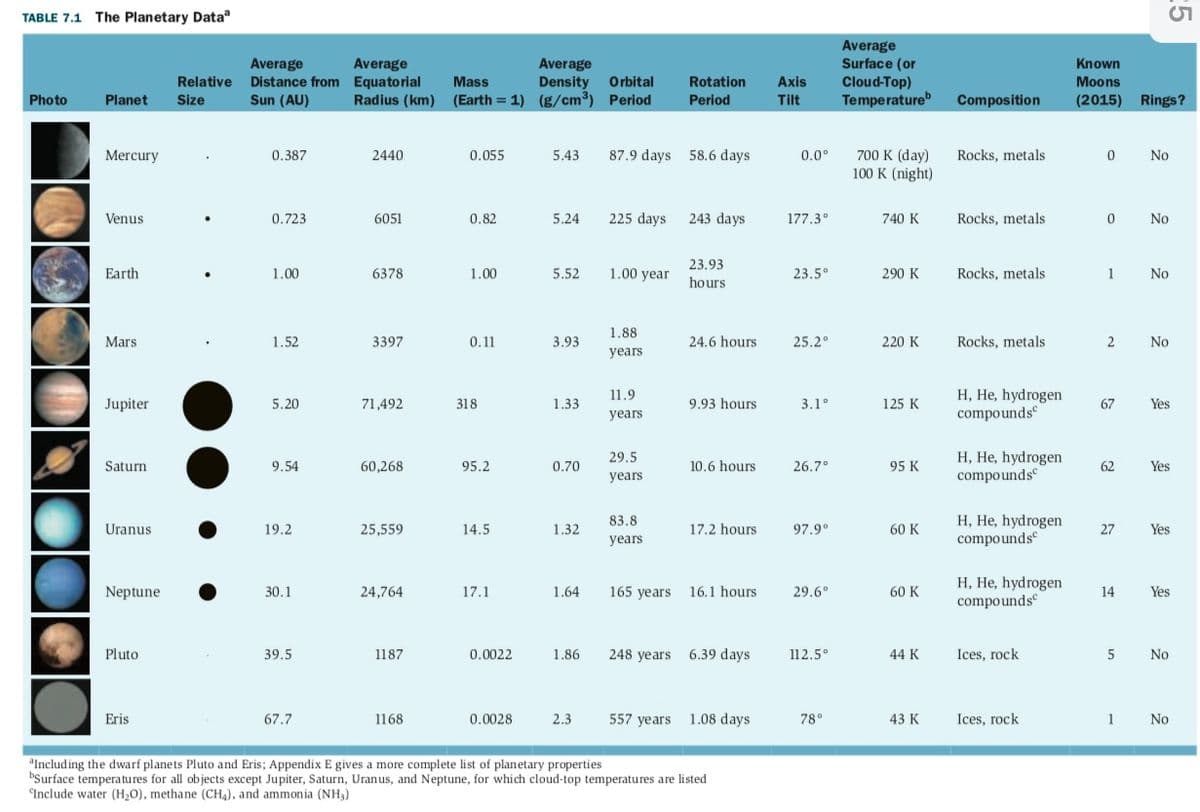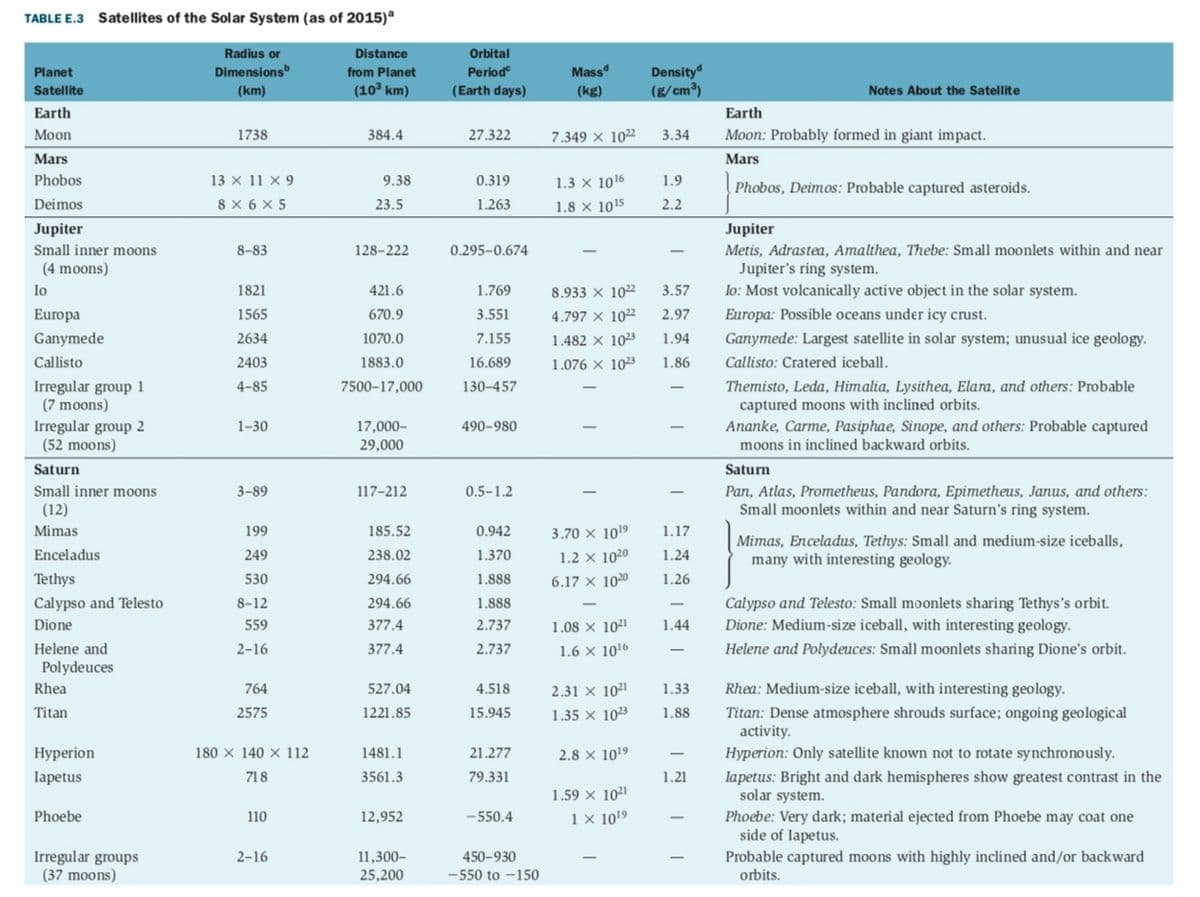Use the planetary data in Table 7.1 and Appendix E to answer each of the following. a. Which column of data would you use to find out which planet has the shortest days? Do you see any notable differ- ences in the length of a day for the different types of plan- ets? Explain. b. Which planets should not have seasons? Why? c. Which column tells you how much a planet’s orbit deviates from a perfect circle? Based on that column, are there any planets for which you would expect the surface temperature to vary significantly over its orbit? Explain.
Use the planetary data in Table 7.1 and Appendix E to answer each of the following. a. Which column of data would you use to find out which planet has the shortest days? Do you see any notable differ- ences in the length of a day for the different types of plan- ets? Explain. b. Which planets should not have seasons? Why? c. Which column tells you how much a planet’s orbit deviates from a perfect circle? Based on that column, are there any planets for which you would expect the surface temperature to vary significantly over its orbit? Explain.
Applications and Investigations in Earth Science (9th Edition)
9th Edition
ISBN:9780134746241
Author:Edward J. Tarbuck, Frederick K. Lutgens, Dennis G. Tasa
Publisher:Edward J. Tarbuck, Frederick K. Lutgens, Dennis G. Tasa
Chapter1: The Study Of Minerals
Section: Chapter Questions
Problem 1LR
Related questions
Question
Use the planetary data in Table 7.1 and Appendix E to answer each of the following.
a. Which column of data would you use to find out which planet has the shortest days? Do you see any notable differ- ences in the length of a day for the different types of plan- ets? Explain.
b. Which planets should not have seasons? Why? c. Which column tells you how much a planet’s orbit deviates from a perfect circle? Based on that column, are there any planets for which you would expect the surface temperature to vary significantly over its orbit? Explain.

Transcribed Image Text:TABLE 7.1 The Planetary Data
Average
Surface (or
Cloud-Top)
Temperature
Average
Average
Average
Distance from Equatorial
Radius (km)
Known
Relative
Mass
Density
Orbital
Rotation
Axis
Moons
Photo
Planet
Size
Sun (AU)
(Earth = 1) (g/cm3) Period
Period
Tilt
Composition
(2015) Rings?
0.387
87.9 days 58.6 days
700 K (day)
100 K (night)
Mercury
2440
0.055
5.43
0.0°
Rocks, metals
No
Venus
0.723
6051
0.82
5.24
225 days
243 days
177.3°
740 K
Rocks, metals
No
23.93
Earth
1.00
6378
1.00
5.52
1.00 year
23.5°
290 K
Rocks, metals
1
No
hours
1,88
Mars
1.52
3397
0.11
3.93
24.6 hours
25.2°
220 K
Rocks, metals
No
years
H, He, hydrogen
compounds
11.9
Jupiter
5,20
71,492
318
1.33
9.93 hours
3.1°
125 K
67
Yes
years
H, He, hydrogen
compounds
29.5
Saturn
9.54
60,268
95.2
0.70
10.6 hours
26.7°
95 K
62
Yes
years
H, He, hydrogen
compounds
83.8
Uranus
19.2
25,559
14.5
1.32
17.2 hours
97.9°
60 K
27
Yes
years
H, He, hydrogen
compounds
Neptune
30.1
24,764
17.1
1.64
165 years
16.1 hours
29.6°
60 K
14
Yes
Pluto
39.5
1187
0.0022
1.86
248 years
6.39 days
112.5°
44 K
Ices, rock
No
Eris
67.7
1168
0.0028
2.3
557 years 1.08 days
78°
43 K
Ices, rock
1
No
"Including the dwarf planets Pluto and Eris; Appendix E gives a more complete list of planetary properties
bSurface temperatures for all objects except Jupiter, Saturn, Uranus, and Neptune, for which cloud-top temperatures are listed
"Include water (H20), methane (CH4), and ammonia (NH3)
-5

Transcribed Image Text:TABLE E.3 Satellites of the Solar System (as of 2015)ª
Orbital
Period
Radius or
Distance
Dimensions
Mass
Density"
(g/cm)
Planet
from Planet
Satellite
(km)
(10° km)
(Earth days)
(kg)
Notes About the Satellite
Earth
Earth
Moon
1738
384.4
27.322
7.349 x 10²
3.34
Moon: Probably formed in giant impact.
Mars
Mars
Phobos
13 x 11 × 9
9.38
0.319
1.3 x 1016
1.9
Phobos, Deimos: Probable captured asteroids.
Deimos
8 X 6 X 5
23.5
1.263
1.8 x 1015
2.2
Jupiter
Jupiter
Small inner moons
8-83
128-222
0.295-0.674
Metis, Adrastea, Amalthea, Thebe: Small moonlets within and near
(4 moons)
Jupiter's ring system.
lo: Most volcanically active object in the solar system.
Io
1821
421.6
1.769
8.933 x 102
3.57
Europa
1565
670.9
3.551
4.797 × 102
2.97
Europa: Possible oceans under icy crust.
Ganymede
2634
1070.0
7.155
1.482 x 1023
1.94
Ganymede: Largest satellite in solar system; unusual ice geology.
Callisto
2403
1883.0
16.689
1.076 x 1023
1.86
Callisto: Cratered iceball.
Irregular group 1
(7 moons)
130-457
Themisto, Leda, Himalia, Lysithea, Elara, and others: Probable
captured moons with inclined orbits.
Ananke, Carme, Pasiphae, Sinope, and others: Probable captured
moons in inclined backward orbits.
4-85
7500-17,000
Irregular group 2
(52 moons)
1-30
17,000–
490–980
29,000
Saturn
Saturn
Small inner moons
0,5-1.2
Pan, Atlas, Prometheus, Pandora, Epimetheus, Janus, and others:
Small moonlets within and near Saturn's ring system.
3-89
117-212
(12)
Mimas
199
185.52
0.942
3.70 x 1019
1.17
Mimas, Enceladus, Tethys: Small and medium-size iceballs,
many with interesting geology.
Enceladus
249
238.02
1.370
1.2 x 1020
1.24
Tethys
530
294.66
1.888
6.17 x 1020
1.26
Calypso and Telesto
294.66
Calypso and Telesto: Small moonlets sharing Tethys's orbit.
Dione: Medium-size iceball, with interesting geology.
8-12
1.888
Dione
559
377.4
2.737
1.08 x 1021
1.44
Helene and
2-16
377.4
2.737
1.6 x 1016
Helene and Polydeuces: Small moonlets sharing Dione's orbit.
Polydeuces
Rhea
764
527.04
4.518
2.31 x 1021
1.33
Rhea: Medium-size iceball, with interesting geology.
Titan
2575
1221.85
15.945
1.88
Titan: Dense atmosphere shrouds surface; ongoing geological
activity.
1.35 x 103
Нуperion
180 x 140 x 112
1481.1
21.277
2.8 x 1019
Hyperion: Only satellite known not to rotate synchronously.
3561.3
lapetus: Bright and dark hemispheres show greatest contrast in the
solar system.
Iapetus
718
79.331
1.21
1.59 x 1021
Phoebe
12,952
-550.4
1 × 1019
Phoebe: Very dark; material ejected from Phoebe may coat one
side of Iapetus.
110
Irregular groups
(37 moons)
Probable captured moons with highly inclined and/or backward
orbits.
2-16
11,300–
25,200
450-930
-550 to -150
Expert Solution
This question has been solved!
Explore an expertly crafted, step-by-step solution for a thorough understanding of key concepts.
This is a popular solution!
Trending now
This is a popular solution!
Step by step
Solved in 3 steps

Recommended textbooks for you

Applications and Investigations in Earth Science …
Earth Science
ISBN:
9780134746241
Author:
Edward J. Tarbuck, Frederick K. Lutgens, Dennis G. Tasa
Publisher:
PEARSON

Exercises for Weather & Climate (9th Edition)
Earth Science
ISBN:
9780134041360
Author:
Greg Carbone
Publisher:
PEARSON

Environmental Science
Earth Science
ISBN:
9781260153125
Author:
William P Cunningham Prof., Mary Ann Cunningham Professor
Publisher:
McGraw-Hill Education

Applications and Investigations in Earth Science …
Earth Science
ISBN:
9780134746241
Author:
Edward J. Tarbuck, Frederick K. Lutgens, Dennis G. Tasa
Publisher:
PEARSON

Exercises for Weather & Climate (9th Edition)
Earth Science
ISBN:
9780134041360
Author:
Greg Carbone
Publisher:
PEARSON

Environmental Science
Earth Science
ISBN:
9781260153125
Author:
William P Cunningham Prof., Mary Ann Cunningham Professor
Publisher:
McGraw-Hill Education

Earth Science (15th Edition)
Earth Science
ISBN:
9780134543536
Author:
Edward J. Tarbuck, Frederick K. Lutgens, Dennis G. Tasa
Publisher:
PEARSON

Environmental Science (MindTap Course List)
Earth Science
ISBN:
9781337569613
Author:
G. Tyler Miller, Scott Spoolman
Publisher:
Cengage Learning

Physical Geology
Earth Science
ISBN:
9781259916823
Author:
Plummer, Charles C., CARLSON, Diane H., Hammersley, Lisa
Publisher:
Mcgraw-hill Education,